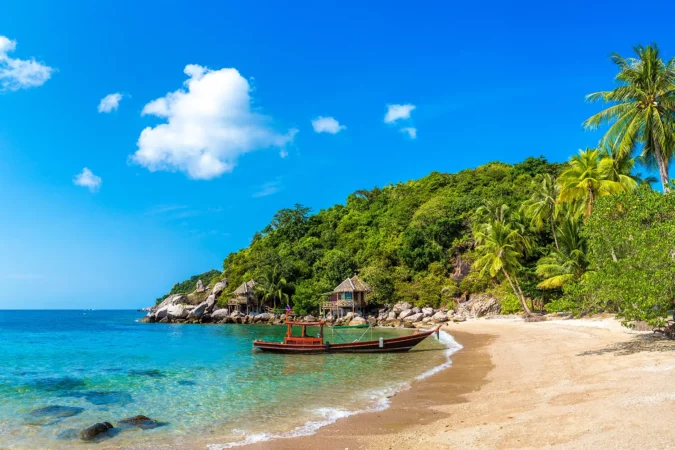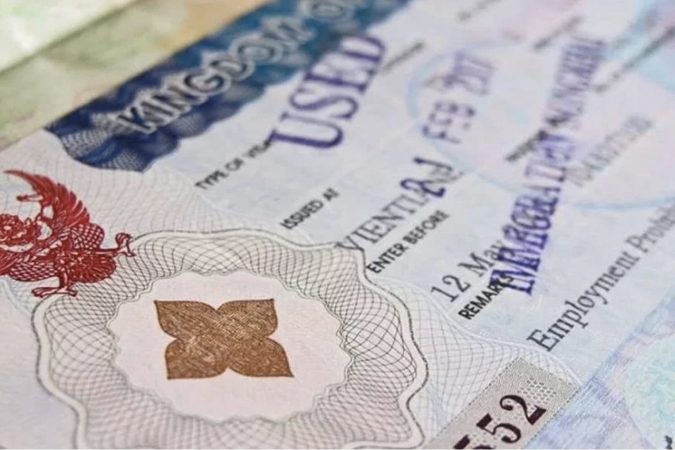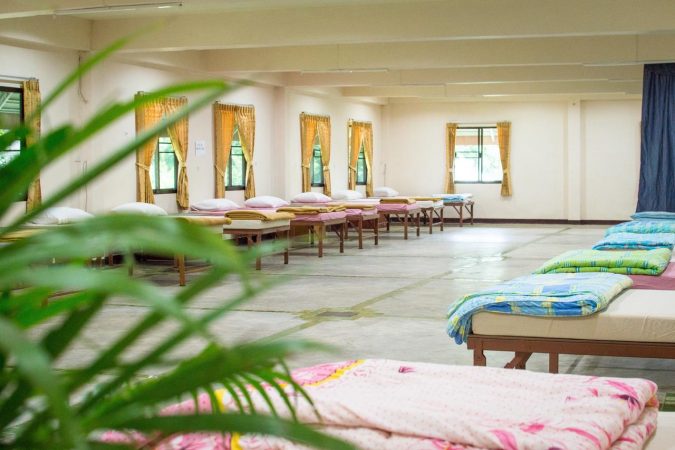So, you want to learn to scuba dive in Thailand? Excellent choice! There’s no better feeling than exploring the ocean’s depths as a scuba diver. It truly is another world down there, and that magical environment will captivate you and keep you diving for the rest of your life. Scuba diving in Thailand is an amazing experience, and Koh Tao is easily the best place to start learning. The island not only offers over 25 year-round dive sites (including a sunken World War II boat), but also has some of the calmest clear blue waters that help new divers focus on learning.
With over 60 dive shops on the island, you might be wondering what the best diving school in Koh Tao is. It’s impossible to narrow it down to just one shop, but there are several ways to weed out the inferior shops. Now, if you don’t know a single thing about diving, don’t fret! We here at Road Affair have done all the in-person research for you. All you need to do is follow this guide, and the next thing you know, you’ll be under the sea (yes, we just quoted the banger from The Little Mermaid).
How to Get to Koh Tao
Koh Tao can be tricky to reach, as it doesn’t have an airport. However, the neighboring island of Koh Samui does, and it takes 1.5-4 hours to ride from Koh Samui to Koh Tao on the ferry, depending on the one you choose. You can find ferry schedules, routes, and tickets at 12Go Asia.
From Koh Samui: Koh Samui has four piers that offer ferries, the main two being Maenam Samui and Na Thon Koh Samui Songserm. Both of these piers offer 1.5-hour ferries to Koh Tao for 700 baht (about $20). The cheapest ferries also run from both piers and cost 600 baht (about $17.50) for a four-hour journey.
From Bangkok: You can book a bus and ferry ticket from 12Go Asia for 1,250 baht (about $36), which includes an eight-hour bus ride from Bangkok and then a roughly two-hour ferry crossing to Koh Tao.
From Phuket: This trip takes 8-10 hours by boat and bus, depending on where in Phuket you’re coming from. The cheapest and fastest option takes eight hours and costs 1,600 baht (about $47).
Other option: You could also fly to Surat Thani, whose airport is likely the cheaper option to fly to from where you are. You can find flights for as cheap as $38, depending on when and where you go. The downside is that you’ll have a longer ferry ride to Koh Tao (4.5 hours), and the ferries don’t leave after noon unless you take the night boat. The cheapest transit option is the overnight ferry from Surat Thani to Koh Tao, which costs around 850 baht ($25) and also accounts for one night’s accommodation. Alternatively, you can book an airport transfer and a high-speed ferry for 1,100 baht (about $32).
Note: If you book the Seatran Ferry, be aware that it doesn’t leave from or arrive in Surat Thani. If that’s where you are, you’ll need to take the bus to Seatran’s pier, which is an hour away.
Dangers of Scuba Diving in Koh Tao
Getting scuba certified in Thailand is as safe as it is anywhere else in the world. Diving used to be a highly dangerous activity, but technology (such as dive computers) has made it a lot safer over the last 25 years. Still, there’s a risk factor with any outdoor activity, so it’s extremely important to get a good dive shop to train you (we’ll expand on this in the next section). Ultimately, you’re in charge of your own safety, but a good class teaches you the skills to dive safely.
There are horror stories about Koh Tao visitors who weren’t properly taught how to equalize and blew out their eardrums, dived in rough conditions that were unsuitable for their skill level, or even died from decompression sickness. This is why we really stress how important it is to train with a high-standard dive school in Koh Tao and take the course seriously.
In case something does happen to you while you’re scuba diving in Koh Tao, make sure you’re covered by health insurance. Some schools offer coverage as part of their packages, but you might want the peace of mind of being covered in advance. SafetyWing offers affordable travel health insurance that covers scuba diving for only about $10 a week. You can request a nonbinding quote below.
Fitness and Health Check Before Diving in Koh Tao
Before you begin your dive course, you’ll be asked to fill out a waiver stating any and all medical conditions that may affect your ability to dive. If you lie on this form and something happens to you, your insurance will not cover you.
Always be honest on your medical form, as most conditions can be assessed by a doctor on the island, and you’ll most likely be cleared to dive afterward. It’s an extra safety step to ensure you won’t suffer an emergency underwater or jeopardize the safety of your dive group.
Complications may arise for divers who take prescription pills or have a history of certain illnesses. Consult a doctor before signing up for a diving course if you have any of these conditions:
- Asthma
- Epilepsy
- Diabetes
- Heart disease
- Pneumothorax
- History of seizures
- Depression
Another thing to consider is your fitness level and swimming ability. Obviously, diving takes place in the water, so you need to know how to swim – but conditions are different on every dive. Sometimes there are heavy currents that make diving more challenging, or you need to swim above the water for a while to reach the site where you descend. This is why you should take your fitness level into account when you’re considering getting your open-water dive certification in Koh Tao.
Why You Should Never Book Dive Within 24 Hours of Flying
One of the biggest rules of scuba diving is that you cannot fly within 24 hours of your last dive. This has to do with the pressurization and the prevention of decompression sickness. When you dive, your cylinder tank will be filled with a mixture of nitrogen and oxygen. As you dive deeper, the pressure on your body will increase and you’ll absorb more nitrogen, as the pressure makes it harder to expel.
When ascending in diving, you’ll have to take breaks (depending on the depth you dive) to give the nitrogen more time to release and prevent decompression sickness. The process of releasing nitrogen still happens when you’re out of the water. Flying also adds pressure to the body, increasing your risk of decompression sickness if your body is still trying to expel nitrogen. This is why it’s important to book your dives or diving course according to your travel plans and never fly within 24 hours of your last dive.
How to Find a Good Dive Shop in Koh Tao
Once you’ve landed in Koh Tao, you’ll be overwhelmed by the number of dive shops offering certifications. This is a common criticism of Koh Tao, as visitors wonder how the standards of dive instructors can be high if there are so many shops that need instructors. This is a valid concern – some shops don’t hold high standards for their teachers and training programs.
You should choose a high-standard dive school for both your safety and an enjoyable experience. So, let’s dive (pun intended) into how you can find the best shops.
Quick answer: Our favorite dive school in Koh Tao is La Bombona Diving. Its instructors are extremely friendly and knowledgeable, and your safety is their first concern.
Read Reviews of Dive Schools
With over 60 dive shops and diving resorts in Koh Tao, we don’t expect you to vet each one thoroughly, but browsing online reviews is a good place to start. Google Reviews and TripAdvisor are some useful resources for this. For example, La Bombona Diving has close to 1,000 reviews and an overall rating of five stars on TripAdvisor and GetYourGuide.
Look out for low ratings and red flags in reviews, such as complaints of accidents due to incompetent instructors or faulty equipment. (Just keep in mind that there are two sides to every story, and some accidents could be due to a student not paying attention during training.) Narrow the shops down to about five that you’ll visit to ask questions.
Visit the Dive Shops in Person
Visit each Koh Tao diving school that you’re seriously considering to get a feel for the shop and instructors. You should look for and ask about several factors on this visit.
First, check out your prospective diving instructor and their certifications. Ask to speak to the person who will be your instructor and sit down with them for a chat. Instructors should have no issues doing this, as they’ll generally want to make sure their school is the right fit for you.
Don’t be afraid to ask lots of questions. Instructors were once in your position, so they understand you might have concerns or inquiries! How they act during the chat is a good indicator of how they’ll run the classroom. Pay attention to their mannerisms and level of professionalism. Are they impatient with you or rushing the conversation? Do they speak your language fluently? Can they answer all your questions?
A dive instructor must renew their instructing license every year. Ask to see your prospective instructor’s license to make sure they follow all international diving guidelines and that their license hasn’t expired. All dive instructors need a CPR and first-aid certification, which they must renew every two to three years, along with an EFR (Emergency First Response) certification that they must renew every two years, so ask when their last refresher course was for both certifications.
Young dive instructors can be just as good as (or better than) seasoned ones. However, if you find comfort in knowing your instructor is highly experienced, you can always ask to see their dive log. This is more indicative of their experience level than how many years they’ve been a dive instructor is. A well-seasoned instructor should have over 300 logged dives.
You’ll be spending quite a few days around the shop to get your open-water dive certificate, so note the vibe of each shop you visit. Are the people friendly? Is the building run-down? Is there air conditioning in the classroom?
Don’t be afraid to ask students in the shop how they like the course as well! These are some good questions to ask other diving students:
- How big is your class?
- How do you like the instructor’s teaching style?
- Do you get briefed before every ocean dive? (This is a crucial practice!)
- Do you feel you’ve learned the skills to dive confidently?
- Have there been any incidents in your group?
- Is food and drink included in the course? (Let’s be real – we’re all suckers for free food!)
Ask About Class Size and the Dive Boat
You should ask the shop how many students and instructors will be in your class. For the best training, the ideal class size is four students (two dive buddy groups) per dive instructor. For example, if your class has 6-8 students, there should be two instructors. This allows more one-on-one time to perfect your skills and ask questions.
La Bombona Diving caps each class at four students and never mixes different language groups in its classes.
Also ask about the maximum diver capacity of the boat you’ll be completing dives with and how many other divers will be on board. Some of these boats are extremely packed, which makes it hard to keep track of your equipment and prepare for a dive. The chaos of many people maneuvering around a boat with large oxygen tanks strapped on can lead to mistakes when you’re preparing your own equipment for a dive, which could put your safety at risk.
Check Out the Equipment and Training Sites
Now it’s time to dive into more tedious questions. When you check out a shop, ask how old its equipment is and to see the equipment in person. Equipment that looks torn, scratched, or generally in poor condition is a red flag – as is wet equipment piled up on the floor instead of hung to dry after being rinsed. Ask the shop staff how they take care of their equipment if you can’t tell, and make sure they have equipment in your size. As a beginner diver, you’ll want reliable equipment so you can focus on your training and avoid any incidents.
Another extremely important question to ask is if the dive shop has a swimming pool for training. Most dive shops have their own pool or are affiliated with a pool elsewhere on the island, but some of them cheap out on this front and claim they do their training in shallow ocean waters with pool-like conditions. While this isn’t the worst thing, it’s definitely more dangerous, as currents and other varying conditions could affect your dive training. Learning in a pool guarantees good visibility and calm waters.
Also make sure there are no hidden equipment fees and that you’ll have all the latest gear available – including a dive computer or watch, which will increase your ability to dive safely. Some schools charge extra for the use of dive computers, so always ask in advance.
Ask How Much It Costs and What’s Included
The cost of scuba diving in Thailand is among the lowest in the world. Earning an open-water dive certification there costs about 9,000-11,000 baht ($262-$320). While this is an excellent price, you’ll still want to get the most bang for your buck.
Always ask what the dive cert package includes. Dive resorts usually offer discounted accommodation, and many dive shops partner with hotels and hostels to offer the same deal. Most shops offer free shuttles to and from your accommodation, so there’s no need to rent a scooter for those days. Other inclusions to ask about are food, drinks, insurance, and other transportation.
Once you complete your open-water diving certification, you can join some Fun Dives! Fun Dives are the cheapest diving in Thailand, though the price varies by package and number of dive sites. The average price range is 700-1,400 baht.
Find a Good Dive Buddy
We recommend getting your dive certificate with a friend, even if it’s someone you just met on the island. To become a certified scuba diver, you’ll have to train with a dive buddy. A dive buddy is extremely important for your safety underwater. They’ll provide equipment checks, stay close to you during dives, and be your go-to person underwater for communicating emergencies. That’s a lot of trust to put in a stranger, so make sure your dive buddy speaks the same language and is taking the course just as seriously as you are to prevent any accidents.
Watch Out for Seller Red Flags
Like any business, scuba dive schools are ultimately trying to make money. This can lead to unsavory practices by some sellers.
One red flag is a seller saying you’ll get more than the standard four ocean dives in your open-water certificate. This means they’ll be training you in the ocean instead of a pool, and you won’t really get extra open dives. You need to focus on the skills and instructor while training, and this can be a lot harder with the potential currents and visibility issues in the ocean. Don’t fall for this gimmick!
Another red flag is the seller brushing off any medical conditions you have. If they tell you to lie on the form or that your condition is most likely fine to dive with, that’s a massive problem. It shows the school’s disregard for your safety, so you should book somewhere else.
Which Scuba Certification Should I Get?
Each dive shop is affiliated with a larger certification company. PADI and SSI are the largest and most widely accepted diving certifiers in the world. Both follow the standards laid out by the World Recreational Scuba Training Council, so we recommend going with one of those two.
SSI and PADI Comparison
SSI and PADI run their courses slightly differently, so the better choice largely depends on how you want to learn. PADI tends to focus on video learning as well as step-by-step training. This means students must master a certain skill before moving on to the next and instructors don’t do as much in-person training. SSI takes a more flexible approach, allowing students to revisit skills they struggled with to master them, and focuses more on instructor teaching than videos.
SSI is better for those on a tight budget. Its program offers free online course materials, unlike PADI, which usually charges for online and physical course materials. It’s also cheaper to get your physical dive certification card with SSI than with PADI, but both offer free digital versions of your card that will be accepted worldwide.
Another advantage of SSI over PADI is the accessibility of its app. Both companies have mobile apps that let students log dives and access learning material. However, SSI has put a lot more time and technology into its app, making it more user-friendly. PADI divers often complain about the app glitching out, which could get annoying when you’re trying to log dives.
If you like the idea of becoming a dive instructor, you might also want to know the difference between dive instructor certifications with PADI and SSI. Even if you don’t want to be an instructor, it’s good to know when you’re scouting out dive shops.
Those who become dive instructors through PADI are autonomous and can practice in any dive shop, even one affiliated with another certification company. This allows flexibility with jobs, but the downside is that the instructor is fully responsible for accidents.
Instructors who certify with SSI are limited to practicing in shops affiliated with the company. While this is less flexible in terms of job availability, it means the shop shares responsibility for accidents with the instructor. This tends to lead to SSI shops having higher standards for instructors, as they’ll also be on the line if anything goes wrong.
Best Scuba Dive Shops in Koh Tao
La Bombona Diving (SSI)
La Bombona Diving on Sairee Beach is one of the best dive schools in Koh Tao. This multi-language five-star school offers a four-day dive course certified under SSI, and it guarantees instructors with more than a year of teaching experience.
Koh Tao Scuba Club (SSI)
Koh Tao Scuba Club is an affordable, fun and friendly dive shop with truly excellent instructors. They offer an all-inclusive open-water dive certification for 9,000 baht, as well as discounted hostel and hotel rooms at Blue Gelato House & Hostel. It even offers 10% discounts on Fun Dives once you graduate, plus a free T-shirt!
Roctopus Dive (SSI)
Another fantastic, highly rated school is Roctopus Dive (what a great name!). One of the best things about this school is that all the information you need is on its website, including pictures of all its facilities. It guarantees classes of no more than four students per instructor, and it even has a dive bar at its beach location, where you can relax with your fellow students after a day of diving.
Phoenix Divers (SSI)
This beachfront diving school is another excellent option, offering the open-water diving certification in three days for 9,500 baht. It has operated on the island for over 20 years and guarantees a small class – no more than four students and one instructor.
Ocean Sound Dive + Yoga (PADI)
Limber up with a yoga class before joining the highly rated open-water dive certification course at Ocean Sound. This dive resort on Koh Tao is LGBTQ-friendly and will have you certified in three days.
Frequently Asked Questions About Diving in Koh Tao
How Long Is the Open-Water Diving Course?
Diving schools’ certification courses typically last three or four days. The course consists of in-class teaching, five dives (including a pool session), and a written exam. You’ll have to study and learn outside of the classroom as well to prepare for the exam.
Can I Dive if I Wear Glasses?
Absolutely! Diving is perfectly safe for those who wear glasses. You can wear contacts while diving or get a custom-made prescription mask.
What Is the Minimum Age to Complete the Open-Water Certification Course?
The minimum age for dive students is 10 years old.
How Deep Can I Dive With an Open-Water Dive Certificate?
Once you complete the beginner course, you can dive as deep as 18 meters. If you want to dive deeper or learn more skills (such as night diving, wreck diving, and deep diving), consider getting your advanced dive certificate. This certification allows you to dive a maximum of 30 meters.
What Are the Best Dive Sites in Koh Tao?
The best dive sites somewhat depend on your certification level. For example, the WWII wreck of the HTMS Sattakut is roughly 30 meters underwater, so it’s only good for divers with advanced certifications. Generally speaking, the best dive sites in Koh Tao are Chumphon Pinnacle, Shark Island, Southwest Pinnacle, White Rock, Sail Rock, and the natural reef maze of Green Rock. All these sites offer unique diversity of marine life, including turtles, whale sharks, barracuda, and massive groupers.
What’s the Average Temperature of the Waters in Koh Tao?
Koh Tao offers warm water for divers, the average temperature being 26-30 degrees Celsius all year round.
Can I Bring My GoPro or Underwater Camera on an Educational Dive?
You can sometimes bring an underwater camera on an educational dive, but it’s ultimately up to the instructor. You are in a course, so your focus should be on practicing your skills and staying safe. If the instructor lets you take your camera underwater, they’ll typically wait for one of the final dives in the course to ensure you’ve mastered buoyancy and the necessary skills to avoid putting yourself or the environment at risk.
Only bring an underwater camera if you can use it hands-free, as you’ll need your hands to communicate and use your gear. In other words, you’ll need a GoPro with a head or body strap.
When Is the Best Time to Dive in Koh Tao?
Koh Tao divers generally agree that the best time to go diving is anytime between February and September. This tends to be when the waters are calmest and the visibility is best. October to January is the island’s rainy season, making the water conditions and visibility worse by Koh Tao standards.
I’m Scared of Diving. Should I Still Book an Open-Water Diving Course?
Any fears you may have of the sea can be explained and overcome through training and education. However, if you’re truly terrified of the ocean, consider a Try Scuba Diving course. This won’t give you any certification, but it will introduce you to diving so you can get a feel for how you feel!
What Makes Koh Tao So Good for Beginner Divers?
Koh Tao offers mild currents, warm waters, and good visibility all year round, making it ideal for beginner divers. It also has several dive sites with sandy bottoms, granite rock formations, and swim-throughs at multiple depths, which all offer great conditions to practice diving at any skill level.
Becoming a scuba diver and exploring the sea is one of the most incredible experiences. Each dive offers something different, whether it’s swimming alongside whale sharks or diving in bioluminescent waters and exploring old shipwrecks. Once you start diving, you’ll never want to stop! Just remember that you are always in charge of your own safety when diving or learning to dive. Never go diving in conditions that make you uncomfortable or with equipment that isn’t up to par, even if your instructor or dive guide claims it’s fine.
So kick off your new life as an ocean explorer with a scuba certification in Thailand! We promise it lives up to the hype.








Comments